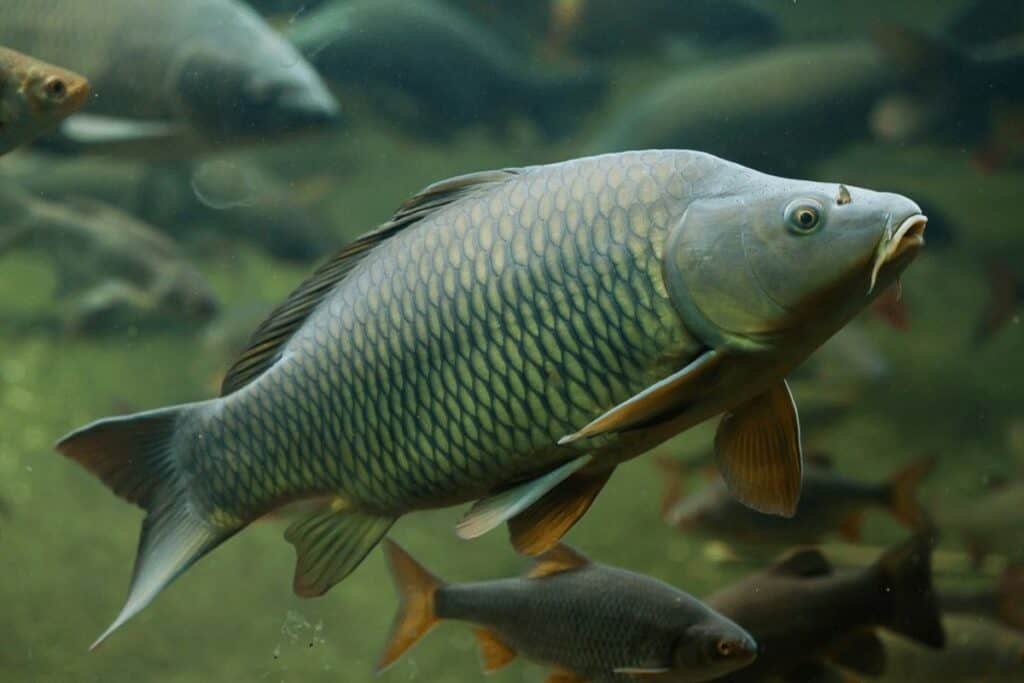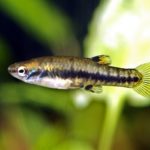Do you want to add another fish to your tank but don’t want one that spends its day chasing everyone else around? If yes, the ideal fish you’re looking for is the Common Carp.
Hailing from the large lakes and rivers in Asia, this fish adapts well to life in captivity and can get massive. But just because the Common Carp is big doesn’t mean it is also aggressive. Instead, it is generally peaceful and cohabitates with other species without causing trouble.
But what are Common Carp’s care needs? Keep reading, and you’ll find out.

Species Summary
Wild populations naturally occur from Europe to Asia in the Black Sea, Caspian Sea, and Aral Sea basins. A wild rheophilic population on the Danube is presumed to be the origin of the European species. Unfortunately, wild populations face the risk of extinction.
Today, the Common Carp (Cyprinus carpio) is bred worldwide and admired for its beauty, resistance, and rapid growth, among other qualities.
They feature barbels on their mouths, which they use to search for food at the bottom of lakes. However, because of their large size, Carps are only suitable for outdoor ponds.
In addition, adults inhabit slow-flowing deep waters, such as lowland rivers and large lakes, with ample vegetation.
Wide varieties of Carp are available, some of which can be expensive. The names of the various types are based on the different patterns and colors displayed by the fish.
There are also colorful domestic varieties known as Nishikigoi. This term is used to designate colored Carp created for ornamental purposes. The beautiful specimens of this fish seem to wear brocade clothing, hence the origin of its name, composed of Nishiki (brocade) and Goi (Carp).
The first Nishikigoi emerged in the mountains of Japan about 180 years ago from some mutations of common Carp bred for food.
Common Carp Care Guide
This Carp care guide will cover some of the basics of Carp keeping, including tank size, tank mates, water parameters, diet, and more.
Tank Size
Due to their large size, which can reach up to 4 feet in length, Carps are not suitable in aquariums. Raising them in small spaces makes the aquarium very susceptible to pollution. Another critical point is that Carp in inadequate aquariums can show atrophy and develop much less than expected, generating health problems.
This fish should be maintained in outdoor tanks and ponds. The recommended tank size is at least 880 gallons.
But here’s the exciting thing: Carps are highly adaptable so you can raise them even in regions with severe winters. They can hibernate and survive even in lakes with ice on the surface.
Tank Mates
Other fish can live with Carp without problems as long as they resist low temperatures in regions with severe winters. They must also be peaceful fish so that there is no aggression among the inhabitants.
The best species to keep with Carp are other species of the same genus or family, such as Goldfish and Loaches.
Same Species Tanks
It is a species of its own to be kept only among its conspecifics. Therefore, it is usually held in large ponds with only other Carp.
Water Parameters
Carp are hardy animals; they can live in different types of water as long as they always tend to the alkaline side and hard water.
The best growth is obtained when the water temperature varies between 73 and 82 F. Salinity up to about 5% is tolerated, and the ideal hardness is between 10 and 15. The ideal pH range is 7 to 8.0.
Additionally, the species can survive low oxygen concentrations (0.3-0.5 mg/l) and supersaturation.
What to Put in Their Tank
They are animals indifferent to decoration; in their natural habitat, they occupy places with the presence of rocks and dense marginal vegetation, which can be copied as decoration.
It is essential to have a soft substrate as sharp or pointed ones can hurt their wattles.
Common Diseases
Every living being is susceptible to contracting a disease, and Carps are no different. They are predisposed to several different bacterial infections and external parasites.
Food and Diet
They are omnivorous fish; adults and juveniles feed on various benthic organisms and plant material.
In their natural environment, they eat everything — small worms, animals, plants, and organic matter found at the bottom of the sand or mud.
In captivity, they willingly accept all types of food you offer in the pond or aquarium. But remember that a varied, high-quality diet is vital to keeping a Carp healthy and happy. And since they tend to beg for food all the time, they are prone to overfeeding. So, please resist the urge to feed them now and then.
Various feeds are available for these animals, including pellets and flakes. Be careful when using live foods such as small fish, as they can bring disease to the pond. Also, you can incorporate earthworms into their diet from time to time.
Lifespan
These fish are one of the longest-lived vertebrates. They live an average of 70 years (the record is 226 years), so they’re both a responsibility and a companion for a lifetime.
Appearance
Depending on the variety, large cycloid scales cover the entire body or just a few clusters in certain spots. It has a very arched body on the back and is more straight in the ventral region. It also has a small mouth filled with short barbels instead of teeth.
There are many varieties of colors, the wild being grayish or brownish. You can also find hundreds of fin patterns. Colors, prints, and size classify about 200 varieties.
Size
These fish reach gigantic sizes, reaching more than 3 feet in total length. But the average size we see out there is around 2.2 feet.
Behavior and Temperament
It is a species that presents peaceful and gregarious behavior, spending most of its time looking for food.
They get used to people and easily allow themselves to be caressed and learn to eat from the hand of the keeper. Although peaceful, Carps can become aggressive when they are close to breeding or suffering from environmental stress. In these times, male Carps chase, intimidate and beat females. It is always an excellent idea to keep more females than males as this helps lessen these fish’s aggression.
Breeding
Common Carp reproduction is typical of cyprinids; an adult female can emit up to 300,000 eggs in a single spawn. Spawning happens along coasts or backwaters. Adults usually migrate considerably during the breeding season to backwaters or flooded formations.
Also, spawning occurs in late spring and early summer (in response to increased water temperature and rainfall. So, to breed them successfully, you will need to make some changes.
First, add a spawn location; mops work great for this. The second is to prepare them for spawning by feeding them a high-quality diet.
Then condition your animals, increasing the amount of high-protein foods over several weeks to prepare them. The females will look for regions of the lake with many plants to spawn. So try to leave an area of the lake with many mops and plants because, after spawning, the male comes to fertilize the eggs.
But that’s not all; Carps practice polyandry, referring to a mating system in which one female mates with multiple males. In short, different make Carps will fertilize the eggs.
After fertilization, the eggs will hatch in about five days, and you will need to have some fried food available. Use infusoria, nauplii, or specific feed for fingerlings.
About three days after hatching, the posterior part of the swim bladder develops; the larvae will swim horizontally and consume small-sized foods such as rotifers and infusoria.
Gender Differences: Male vs Female
Sexual dimorphism is only seen in mature adult Carp, and males are usually distinguished from females by the larger ventral fin.
Generally, females are ready to breed when they reach around age three. Males can develop small white spots called tubercles around the gill areas when they are willing to spawn, while females get larger and plumper.
Common Carp Fun Facts
● Ornamental Carp, colored or patterned, emerged by spontaneous genetic mutation of common Carp in the region of Niigata, Japan, perfecting their characteristics, reaching three hybrid types: the Higoi (red Carp), the Asagui (blue and red Carp) ) and the Bekko (white and black).
● These specimens began to undergo crossbreeding and genetic improvement until breeders defined the magnificent standards established today.
●Nishikigoi is part of Japanese culture, where, in addition to their splendid beauty, they are admired for their imposing body, bright colors, and graceful swimming. Orientals believe that they bring luck and good fluids.
● In China, it is considered an honorable animal. It is one of the few fish that does not struggle when caught. Due to her characteristic of also being a strong animal that swims against the current, she is the main symbol of Chinese honor.
●Many Common Carp species participate in exhibitions throughout their lives.
References.
Alikunhi, K.H., 1966. Synopsis of biological data on common carp Cyprinus carpio (Linnaeus), 1758 (Asia and the Far East). FAO Fish. Synop. 31(2):39p.
Balon, E.K., 1990. Epigenesis of an epigeneticist: the development of some alternative concepts on the early ontogeny and evolution of fish. Guelph Ichthyol. Rev. 1:1-48.
Frimodt, C., 1995. Multilingual illustrated guide to the world’s commercial warmwater fish. Fishing News Books, Osney Mead, Oxford, England. 215 p.
Kottelat, M. and J. Freyhof, 1972. Handbook of European freshwater fish. Publications Kottelat, Cornol and Freyhof, Berlin. 646 pp. (Ref. 59043).
Murdy, E.O., R.S. Birdsong and J.A. Musick, 1997. Fishes of Chesapeake Bay. Smithsonian Institution Press Washington and London. 324 p.
Pethiyagoda, R., 1991. Freshwater fishes of Sri Lanka. The Wildlife Heritage Trust of Sri Lanka, Colombo. 362 p.
Scott, W.B. and E.J. Crossman, 1973. Freshwater fishes of Canada. Bull. Fish. Res. Board Can. 184:1-966.
Ferguson, H. W., Morales, J. A., & Ostland, V. E. (1994). Streptococcosis in aquarium fish. Diseases of Aquatic Organisms, 19(1), 1-6.








